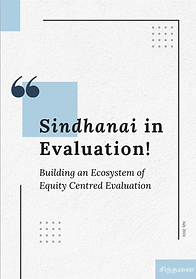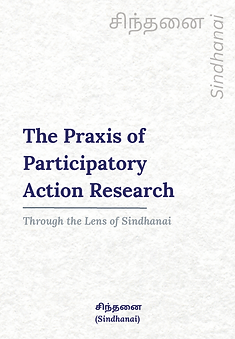Tools & Resources
Explore our expanding repository of writings, toolkits, and learning materials that challenge dominant paradigms and provide community-led perspectives on evaluation. Here, you will find a diverse range of resources designed to inspire critical thinking and promote inclusive practices. Our aim is to rethink evaluation processes and embrace innovative approaches.
We invite you to read on and share any insights or suggestions you may have for the team!


.png)
Sindhanai as Comtemplative Pedagogy:
Embedding Measurement in Collectivisation
The first publication of Sindhanai is an in-depth analysis of the need to understand three aspects of Movements- non-linearity, exi(s)t strategy and intersectionality. It uses the Ambedkarite talisman to understand collectivisation. We explore Sindhanai (critical reflection) as a contemplative pedagogy to understand collectivisation and the need to measure the presence of Sindhanai as the core for collectivisation
Handbook: Complexities in Measuring Collectivisation
The evaluation community often wants to be neutral and unbiased, and thus struggles to understand that measuring collectives demands an explicitly political approach, for the reason that social movements cannot afford to be apolitical. With these considerations in mind, the Sindhanai team has developed this handbook to address the complexities of measuring collectivisation in social movements.
Decolonising Research and Evaluation
Without decolonising research, evaluation and methods, it is difficult to measure collectivisation. Here are two papers where we have explicitly looked at measurement or analysis through the lens of decolonisation.
A Sindhanai on Monitoring & Evaluation
Decolonising UN Pact for the Future
The Praxis of Participatory Action Research
This manual offers a grounded approach to Participatory Action Research (PAR), bringing together its theory, practice, and politics. It positions communities as co-researchers and centres Sindhanai (critical reflection) as the ethical and political core of participatory inquiry. Organised around key stages of the research cycle, the manual traces how power, knowledge, and meaning shift through collective framing, action, and reflection, while also highlighting key watch-outs for practice.
Ethics in Participatory Research
This document rethinks ethics in participatory research from a clear starting point: communities are not subjects, but co-researchers in knowledge creation. Drawing on a decade of experience with community-led ethical review processes, it examines how ethics must be lived in practice—across consent, compensation, positionality, and power—rather than treated as abstract principles. The report foregrounds questions of accountability, reciprocity, and knowledge justice, arguing that ethical practice must actively protect and strengthen communities whose lives are shaped by structural inequalities, while holding institutions and researchers accountable for how power is exercised.











